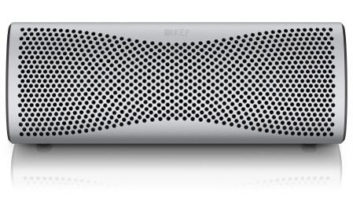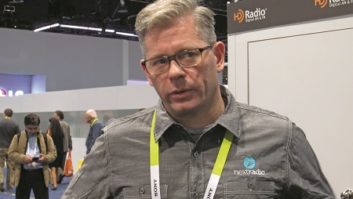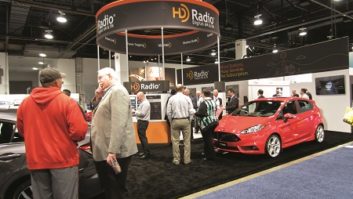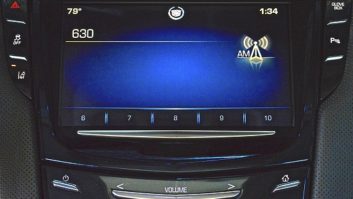LAS VEGAS Chip sets for HD Radio by Samsung and SiPort that are smaller, less expensive and consume less power are being marketed to receiver makers. According to iBiquity President/CEO Bob Struble, that means we’ll see HD Radio portables coming out this year. That category could include iPod accessories as well, he said.
Close to 100 HD Radios are being offered, twice the amount available at this time last year. The challenges for proponents in 2009 remain increasing those offerings, making them less expensive for the consumer and giving them wider distribution — all in the hopes of increasing sales amidst a constricting economy.
Here’s an overview of news related to HD Radio from CES.
Struble Is Realistic Yet Upbeat
Struble told Radio World in an interview at CES that the company assumes all of 2009 will be tough financially, though he said the private firm, which doesn’t disclose its finances, remains well-funded. The company subsequently laid off an undisclosed number of people in January.

The smallest HD Radio receiver to date: the KRI armband portable. Photo by Leslie Stimson In broad terms, Internet radio receiver offerings are growing, and live video and Internet in the car have made gains. Both were themes at this year’s convention.
Against the backdrop of ever-increasing competition for the medium in the car and elsewhere, Struble acknowledged he’s worried about radio, which he says is in “freefall” now with less money and fewer people at stations.
“Radio has challenges. There are other entertainment mediums and plenty of other places to advertise. To remain analog in a world that’s fully digital with all of those choices is probably not the best answer.” He believes innovations made possible with HD Radio technology, such as real-time traffic information on HD2 channels and iTunes tagging, have the potential to help stations bring in revenue.
He is realistic about financial realities: “Yes, we’re worried about the economy. I believe we’re going to be challenged because several of the industries we’re targeting are in trouble.”
However, the iBiquity chief remains optimistic about the technology, saying at only 1 to 2 percent penetration in the auto and receiver markets, HD Radio is in a position to show “good growth” in 2009. Struble cited announcements by Kia and Ford with definite dates to offer HD Radio, as well as more devices coming on the market in ’09 including HD Radio navigation devices, to support his outlook.
Yet in order to take advantages of the data possibilities of IBOC, some broadcasters have said they must have a more robust digital signal and that digital coverage must match that of analog. In order to accomplish that, they argue that they need to raise FM digital power and have asked the FCC to approve a voluntary increase of up to 10 dB.
Struble believes the FCC will approve an FM digital power increase. There are discussions and “additional analysis” going on between the technology developer and commercial and noncommercial broadcasters, he said.
Several sources told Radio World they hope to present test results at the spring NAB Show and present a unified package to the commission to bolster their arguments for an increase.
Proponents “want to do this, they just want to do it in a managed way,” said Struble. “Where we’re going to need to get to is, what does ‘managed’ mean?”
The company notes that the FCC has begun allowing some stations experimental authorizations to raise power and hopes the commission did so to allow proponents to gather more facts.
Given promotion by the radio industry to lobby carriers to include FM chips in cell phones and other personal devices, and considering HD Radio’s focus on multicasting, navigation and iTunes tagging — all FM phenomena — where does that leave AM, Radio World wondered. Of some 1,900 stations using HD Radio technology, most are FM; the number of AMs using the technology does not appear to be growing appreciably.
Struble said, “There’s no doubt that the technical solutions in AM are much more difficult than they are in FM. If AM broadcasters want to take a wait and see approach, that’s fine.”
But iBiquity believes AM broadcasters should be in the digital world as well. “We have a solution that we think works, and it’s really going to be up to them” to make a decision about adopting the technology, Struble said.
HD Radio Delayed But Still in Ford’s Plans
Ford Motor Company has again committed to offering HD Radio, reemphasizing its intentions though stretching out its target dates.

iLuv unveiled a tabletop HD Radio that adds iTunes tagging and is certified to work with the iPhone. Last year, then-Chairman/CEO Rick Wagoner said at CES that HD Radio receivers would join other OEM technologies — including Sync and Sirius Travel Link — in Ford, Lincoln and Mercury vehicles in the 2009 calendar year.
This year, President/CEO Alan Mulally mentioned installing HD Radio in new vehicles and Doug VanDagens, director of connected services, pegged the date as “early in the 2010 calendar year.” He gave no specifics on models or pricing, nor on whether HD Radio would be standard or an option.
Presumably the auto industry’s tough times delayed its HD Radio plans.
By almost all accounts, 2009 will be among the toughest years ever faced by the 20,000 new car dealerships in the U.S., with sales of cars and lightweight trucks projected to shrink by as much as 6 million vehicles from the 16.1 million sold as recently as 2007, according to the National Automobile Dealers Association.
Sales last year were 13.2 million, down 18 percent from 2007, and December sales ran at an annual rate of around 10 million. Last year’s sales were the worst in 26 years, according to the NADA.
U.S. automakers have asked Congress for help. As a condition of its $17.4 billion federal bailout, Chrysler and General Motors Corp., the parent company of Ford, have until Feb. 17 to detail a turnaround plan intended to make them viable through cost-saving deals with the United Auto Workers union and creditors.
Looking to the future, Mulally said his company is looking to provide state-of-the-art digital infotainment systems in its products. The automaker presented a vision of where it hopes to go with Sync, based on Microsoft technology that provides hands-free access to a cell phone, car radio and external music players like iPods.
Sync systems on 2010 Fords will also offer real-time traffic, sports and weather reports and turn-by-turn directions, he said.
Sync will be installed by this fall in nearly a million Ford vehicles, said Mulally. The automaker offers it on 20 models in 2009.
He also unveiled Ford’s concept of a totally configurable “dashboard of the future,” developed in collaboration with Sharp, Microsoft, Sony and Nuance, and featuring SmartGauge with Eco Guide fuel economy capabilities. As part of this dashboard, he demoed an avatar called “Eva” that can read aloud e-mail, perform Internet searches and deliver directions and traffic reports through voice commands.
Also in the future, Ford is looking to provide access to Internet portals like Pandora using buttons on the steering wheel.
Kia Will Factory-Install
It seems 2010 is the year automakers can focus on HD Radio.
Kia Motors will begin offering factory-installed HD Radio receivers in its sedans and SUVs in that calendar year.
Vice President of Marketing Michael Sprague said, “Offering HD Radio technology is the latest example of how we plan to enhance the Kia ownership experience.”
Other automakers that have announced commitments to installing HD Radio include Mercedes, Audi, Hyundai, Volvo, Ford, Scion, Mini, Jaguar and BMW.
HD Radio Enters Real-Time Traffic Category
HD Radio technology has entered the personal navigation device market.
IBiquity showed four navigation prototypes that incorporate HD Radio; two had HD Radio integrated into the unit, one fit into a cradle and another with a cigarette lighter adapter. Manufacturers of the navigation devices included Dual, Cydle, KRI and KRS; the latter two will be sold to other companies, for sale under other brand names.
The prototype KRI armband portable HD Radio receiver and MP3 player is the smallest device into which an IBOC chip is integrated so far. The antenna is in the headset cord.
The PNDs use real-time traffic information broadcast over the data channel of an HD Radio signal.
The Dual XNAV43HD includes a 4.3-inch touch screen, text-to-speech functionality and multimedia support. It ships this summer with a list price of $279.99.
The Cydle T43 has an internal mic for Bluetooth hands-free communication, stereo ear jack, AV out jack and mini USB for PC link and recharging. The 4.3 inch PND with GPS is said to have a battery life of up to four hours. Availability and price were not released.
The Dual XNAV43HD supports reception of Clear Channel Total Traffic Network and Inrix real-time traffic information. Clear Channel announced that real-time traffic services over HD Radio are live and operational in 50 markets.
Receiver Makers Adding Auto, Home HD-R Models
Several receiver manufacturers are increasing their HD Radio model offerings, while other manufacturers new to the technology debut products.
IBiquity Digital showcased approximately 30 brands of radios. Most of the nearly 100 models were priced at around $80. IBiquity’s 40×50 booth included HD Radio receivers in a Volvo and Hyundai, showing that the technology is now available in both high- and low-end cars.
Brands of radio on display included Alpine, iLuv, Jensen Mobile, JVC, Kenwood, Onkyo, Pioneer, Sony and Yamaha.
The Kenwood KTC-HR300 is an add-on module for an “HD Radio-ready” in-dash electronic component. The KTC-HR300 connects to any multimedia or CD receiver source unit, through Kenwood’s Advanced Bus or 5L CD changer control connections. The KTC-HR300 will receive the primary HD Radio signal as well as up to three multicast channels on the same frequency.

IBiquity and NPR Labs were among those involved in the Dice RRS radio to be honored by the Stevie Wonder Sendero Group for accessibility. Photo by Leslie Stimson New is the iTunes Tagging feature, which allows the user to bookmark a song heard on the radio for later online purchase if the compatible Kenwood in-dash model has an iPod connected through the bus system. The unit will list for $150 and ship in March.
New tabletop receivers were unveiled by Acoustic Research, Gigaware, iLuv and Teac, adding to the list of brands with tabletop models that already includes Coby, jWIN, Polk and Sony.
iLuv unveiled a tabletop HD Radio that replaces a current model; it adds iTunes tagging and is certified to work with iPhone. The new iHD171 lists for $199. It replaces the current iPod-docking i169.
Other features include dual alarm clock functions and a video output to watch iPod-stored videos on a connected TV. The iHD171 has 30 programmable presets, auxiliary 3.5mm input and 2×4-watt RMS audio output.
Yamaha has equipped five of nine new components offerings with the digital upgrade.
Dual, Jensen Mobile and JVC are expanding on their presence with new automotive receivers.
JVC has three new in-dash CD receiver models: KD-HDR20, KD-HDR50 and the Arsenal KD-AHD59.
The KD-HDR50 CD Receiver features a built-in HD Radio tuner with multicast capability, front auxiliary input, USB 2.0 connection for iPod/iPhone with two-way control and iTunes Tagging capability. The KD-HDR50 also is ready for a Bluetooth adapter and has MP3/WMA playback capability. The receiver, shipping now, lists for $179.95.
JVC’s Arsenal KD-AHD59 CD Receiver features a built-in HD Radio tuner with multicasting and iTunes Tagging capability, front aux input, and USB 2.0 connection with two-way control for iPod/iPhone. The unit is ready for a Bluetooth adapter, is satellite radio-ready and has MP3/WMA playback capability. The KD-AHD59 also features wireless remote, 5V pre-output terminals and variable-color illumination display, and is steering wheel remote control-ready. The receiver, shipping to retailers now, lists for $159.95.
Also new is the JVC KD-HDR20, featuring a built-in HD Radio tuner with multicast capability, front auxiliary input and MP3/WMA playback. This receiver is ready for a Bluetooth adapter and is satellite- and iPod-ready. The unit is shipping and lists for $139.95.
Pioneer debuted two iTunes Tagging CD radios that work with FM RDS and HD Radio. The DEH-P710BT and DEH-P7100BT include built-in Bluetooth and USB direct control for iPod.
Slated for spring availability, the DEH-P710BT and DEH-P7100BT will list at $360 and $340 respectively.
iLuv, Coby, Denon, Onkyo/Integra and Yamaha are adding to their home HD Radio receiver line.
The majority of Alpine, JVC, Kenwood, Pioneer and Sony receivers are HD Radio Ready.
NPR Preps for Additional Power Increase Tests
NPR Labs is planning follow-up drive testing to pinpoint the best levels for an FM IBOC power increase. Testing will be done with member stations as well as Minnesota Public Radio stations.
Representatives of NPR Labs said they plan to test the concept of whether masking elements in the car affect someone’s perception of the audio. The drive-around tests in Baltimore County, Md., are planned for February and March, with the plan to bring results to the spring NAB convention.
NPR Labs was at CES looking for manufacturers to make units for captioned radio, Braille and blackboard radios, and radio reading service receivers. It plans to award funds for R&D prototyping.
Dice has made a radio reading service receiver and at least additional manufacturer is interested in that effort. A Dice prototype was displayed at the fall NAB Radio Show; it was in several booths at CES.
The idea behind Blackboard radio is to bring school to the kids (instead of the other way around) in Africa using a solar-powered or wind-up radio. The teacher uses an electronic “white board” and that board image and audio are transmitted to the radio using an RDS subcarrier.
NPR Labs also has a new face, Rich Rarey; he’s former master control supervisor of NPR (and a contributor to Radio World). As manager of Strategic Technology Applications for the lab, one of his main tasks is the aggregated story project, in which the radio aggregates related stories and caches them for the listener, a kind of TiVo for radio.
Accessible Awards
The Stevie Wonder Foundation and his Sendero Group, along with the National Federation for the Blind, honored five organizations with Vision Free Awards — iBiquity Digital, National Public Radio, the International Association of Audio Information Services, NDS and Dice Electronics — for HD Radio-enabled conditional access broadcast technologies that support accessible radio for the sight and hearing impaired. All five groups collaborated on the Dice accessible digital radio reading service receiver.
At a reception sponsored by iBiquity, Wonder said he hopes manufacturers will make all devices accessible and read aloud from a song that he debut at the inaugural, saying: “Fear can’t put dreams to sleep.”






